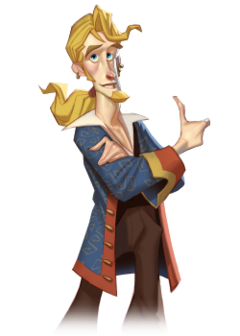
Day of the Tentacle, also known as Maniac Mansion II: Day of the Tentacle, is a 1993 graphic adventure game developed and published by LucasArts. It is the sequel to the 1987 game Maniac Mansion. The plot follows Bernard Bernoulli and his friends Hoagie and Laverne as they attempt to stop the evil Purple Tentacle - a sentient, disembodied tentacle - from taking over the world. The player takes control of the trio and solves puzzles while using time travel to explore different periods of history.

Monkey Island is a series of adventure games. The first four games were produced and published by LucasArts, earlier known as Lucasfilm Games. The fifth was developed by Telltale Games with LucasArts, while the sixth was developed by Terrible Toybox with Lucasfilm Games and Devolver Digital.

Loom is a 1990 fantasy-themed graphic adventure game by Lucasfilm Games. The project was led by Brian Moriarty, a former Infocom employee and author of classic text adventures Wishbringer (1985), Trinity (1986), and Beyond Zork (1987). It was the fourth game to use the SCUMM adventure game engine, and the first of those to avoid the verb–object interface introduced in Maniac Mansion.
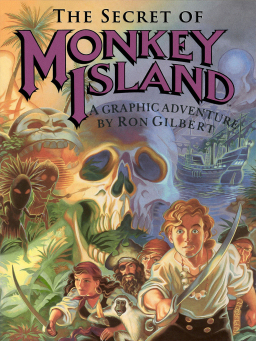
The Secret of Monkey Island is a 1990 point-and-click graphic adventure game developed and published by Lucasfilm Games. It takes place in a fictional version of the Caribbean during the age of piracy. The player assumes the role of Guybrush Threepwood, a young man who dreams of becoming a pirate, and explores fictional islands while solving puzzles.
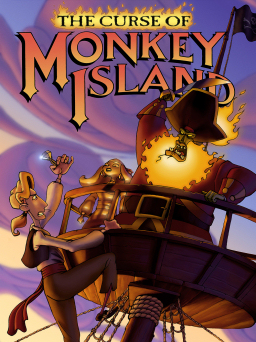
The Curse of Monkey Island is an adventure game developed and published by LucasArts in 1997. A sequel to 1991's Monkey Island 2: LeChuck's Revenge, it is the third game in the Monkey Island series.

Monkey Island 2: LeChuck's Revenge is an adventure game developed and published by LucasArts in 1991. A sequel to 1990's The Secret of Monkey Island, it is the second game in the Monkey Island series. It was the sixth LucasArts game to use the SCUMM engine, and the first game to use the iMUSE sound system. In it, pirate Guybrush Threepwood searches for the legendary treasure of Big Whoop and again faces off against the pirate LeChuck, who is now an undead corpse.

Deluxe Paint, often referred to as DPaint, is a bitmap graphics editor created by Dan Silva for Electronic Arts and published for the then-new Amiga 1000 in November 1985. A series of updated versions followed, some of which were ported to other platforms. An MS-DOS release with support for the 256 color VGA standard became popular for creating pixel graphics in video games in the 1990s.

Escape from Monkey Island is an adventure game developed and released by LucasArts in 2000. It is the fourth game in the Monkey Island series, and the sequel to the 1997 videogame The Curse of Monkey Island. It is the first game in the series to use 3D graphics and the second game to use the GrimE engine, which was upgraded from its first use in Grim Fandango.

From the late 1980s to the early 2000s, LucasArts was well known for their point-and-click graphic adventure games, nearly all of which received high scoring reviews at the time of their release. Their style tended towards the humorous, often irreverent or slapstick humor, with the exceptions of Loom and The Dig. Their game design philosophy was that the player should never die or reach a complete dead-end, although there were exceptions.

Ron Gilbert is an American video-game designer, programmer, and producer. His games are generally focused on interactive story-telling, and he is arguably best known for his work on several LucasArts adventure games, including Maniac Mansion and the first two Monkey Island games. In 2009, he was chosen by IGN as one of the top 100 game creators of all time.
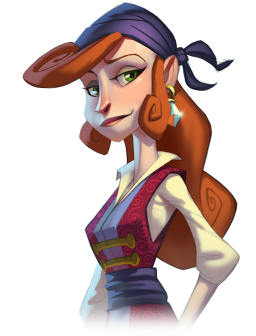
Elaine Marley is a character in the Monkey Island series of graphic adventure video games. Created by Ron Gilbert for LucasArts, the character first appears in The Secret of Monkey Island and is one of the core characters in the franchise. Originally conceived as a ruthless island governor, the character evolved during development into the protagonist's love interest. While the first two games in the series did not feature voice acting, Elaine was voiced by Alexandra Boyd in The Curse of Monkey Island and by Charity James in Escape from Monkey Island; Boyd would reprise the role for later entries in the franchise.

Dominic Armato is an American voice actor, journalist and food critic. He is best known for his work on LucasArts games. His most famous role is the voice of the pirate Guybrush Threepwood in the Monkey Island series.
iMUSE is an interactive music system used in a number of LucasArts video games. The idea behind iMUSE is to synchronize music with the visual action in a video game so that the audio continuously matches the on-screen events and transitions from one musical theme to another are done seamlessly. iMUSE was developed in the early 1990s by composers Michael Land and Peter McConnell while working at LucasArts. The iMUSE system was patented by LucasArts in 1994, after being added to the fifth version of the SCUMM game engine in 1991.
April Ryan is a fictional character from the adventure game The Longest Journey (1999) and its sequel Dreamfall: The Longest Journey (2006). In the former, she is the protagonist, and in the latter, one of the three primary characters. April has been praised as one of the most memorable female characters in the history of adventure games. In both games she is voiced by American actress Sarah Hamilton.

In English-speaking popular culture, the modern pirate stereotype owes its attributes mostly to the imagined tradition of the 18th-century Caribbean pirate sailing off the Spanish Main and to such celebrated 20th-century depictions as Captain Hook and his crew in the theatrical and film versions of J. M. Barrie's children's book Peter Pan, Robert Newton's portrayal of Long John Silver in the 1950 film adaptation of the Robert Louis Stevenson novel Treasure Island, and various adaptations of the Middle Eastern pirate, Sinbad the Sailor. In these and countless other books, films, and legends, pirates are portrayed as "swashbucklers" and "plunderers". They are shown on ships, often wearing eyepatches or peg legs, having a parrot perched on their shoulder, speaking in a West Country accent, and saying phrases like "Arr, matey" and "Avast, me hearty". Pirates have retained their image through pirate-themed tourist attractions, film, toys, books and plays.

Frank West is a character in Dead Rising, an action-adventure video game series created and published by Japanese company Capcom. He first appeared as the protagonist in the 2006 video game Dead Rising. In the series, West is a freelance journalist. The character has been well received by video game publications as well as by the fans, mainly in the West, leading Frank to appear in several more games in and outside the Dead Rising series.
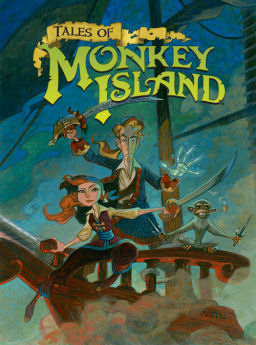
Tales of Monkey Island is a 2009 graphic adventure video game developed by Telltale Games under license from LucasArts. It is the fifth game in the Monkey Island series, released nearly a decade after the previous installment, Escape from Monkey Island. Developed for Windows and the Wii console, the game was released in five episodic segments, between July and December 2009. In contrast to Telltale's previous episodic adventure games, whose chapters told discrete stories, each chapter of Tales of Monkey Island is part of an ongoing narrative. The game was digitally distributed through WiiWare and Telltale's own website, and later through Steam and Amazon.com. Ports for OS X, the PlayStation Network, and iOS were released several months after the series ended.

Nathan Drake is a fictional character and the protagonist of the Uncharted franchise, most notably in the video game series, developed by Naughty Dog. He appears in all mainline games: Uncharted: Drake's Fortune, Uncharted 2: Among Thieves, Uncharted 3: Drake's Deception, and Uncharted 4: A Thief's End, the spin-offs Uncharted: Golden Abyss and Uncharted: Fight for Fortune, the motion comic prequel series Uncharted: Eye of Indra by DC Comics, and other related media. A charismatic and good-natured yet rebellious treasure hunter, the player controls Drake as he journeys across the world to uncover various historical mysteries. He is played through voice and motion capture by Nolan North, who influenced Drake's personality by ad-libbing segments of the character's dialogue.
Don't Shit Your Pants is a browser-based text adventure game created by Canadian developers Teddy and Kenny "Rete" Lee for Cellar Door Games. The objective of the game is to use a text prompt to prevent a balding man standing beside a closed door in pajama bottoms and an undershirt from defecating inappropriately. It was the first title released by the Lee brothers, receiving positive critical reception.
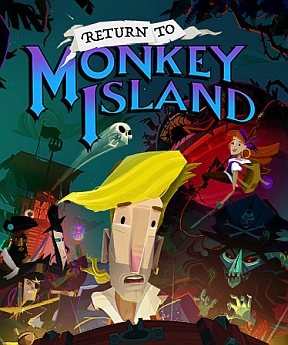
Return to Monkey Island is a point-and-click adventure game developed by Terrible Toybox and published by Devolver Digital. The sixth Monkey Island game, it was released for macOS, Nintendo Switch, and Windows on September 19, 2022, for Linux on October 26, 2022, for PlayStation 5 and Xbox Series X/S on November 8, 2022, and for iOS and Android on July 27, 2023. It was the first Monkey Island game by the series' creator, Ron Gilbert, since Monkey Island 2: LeChuck's Revenge (1991).
